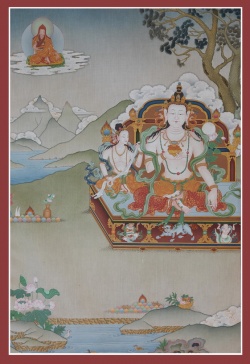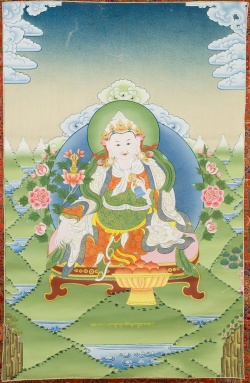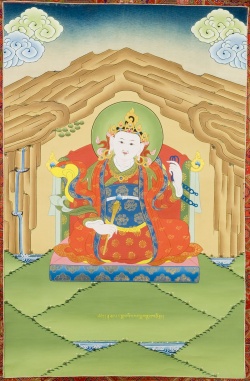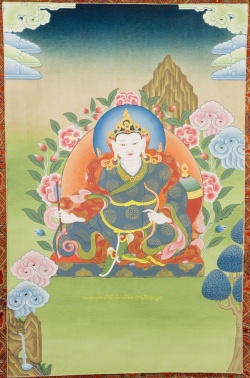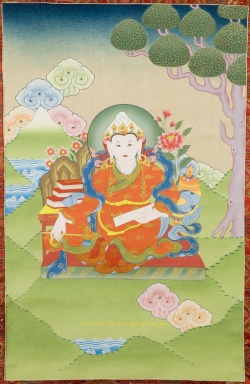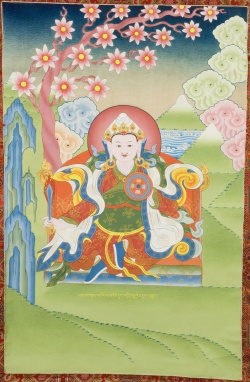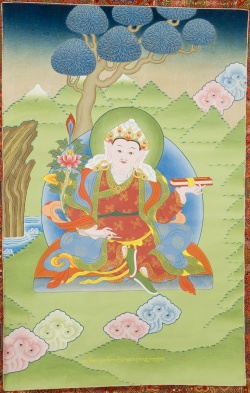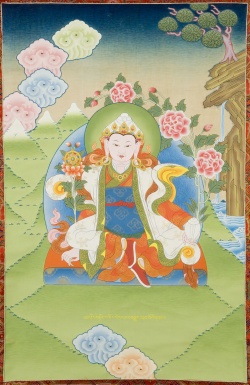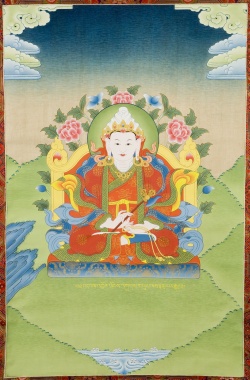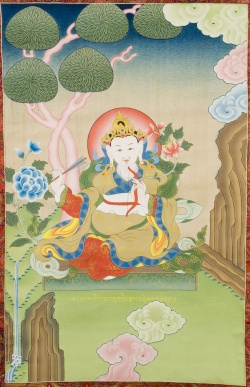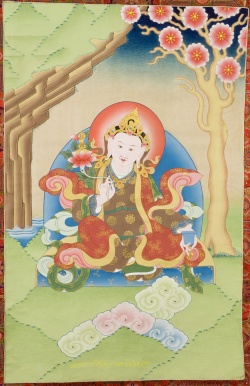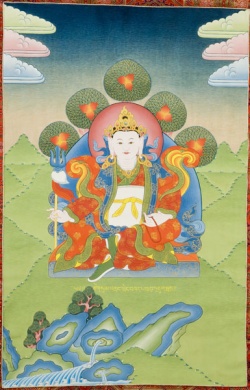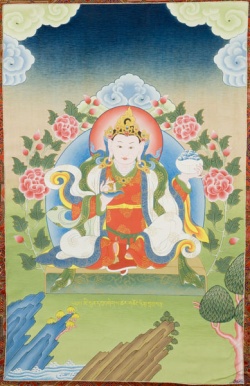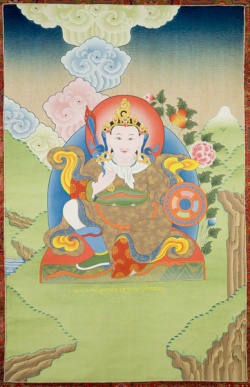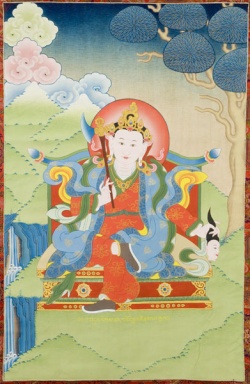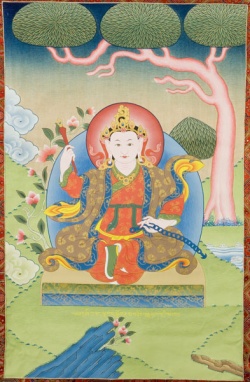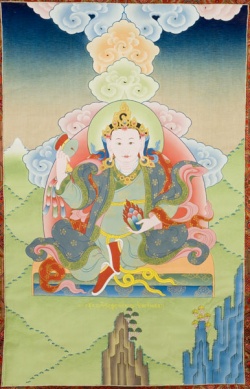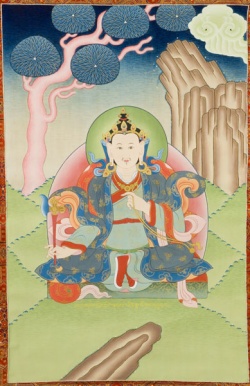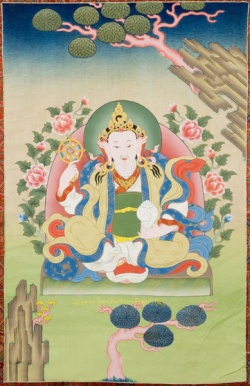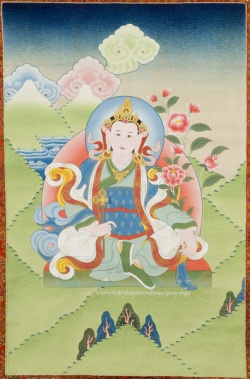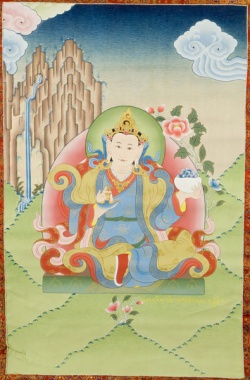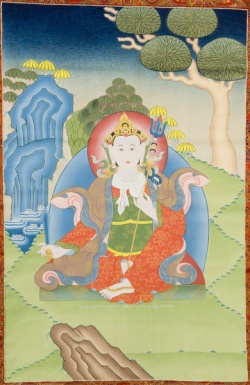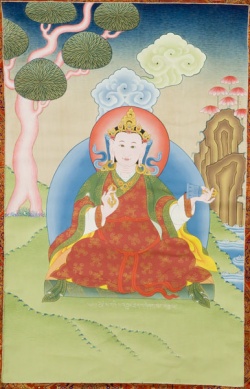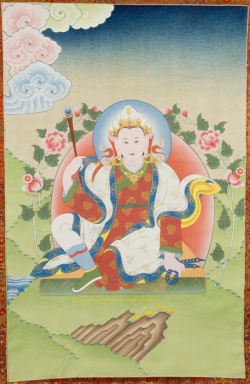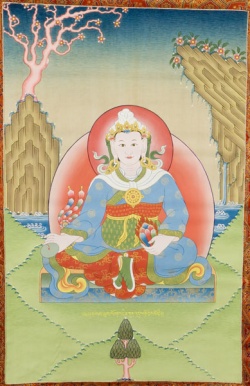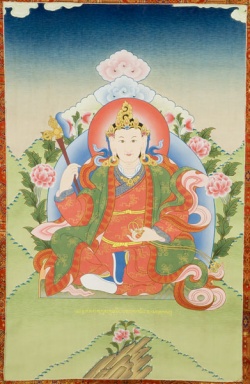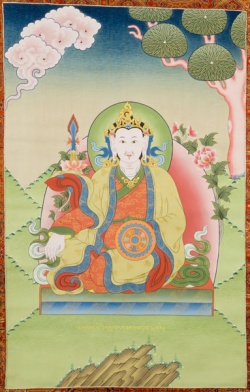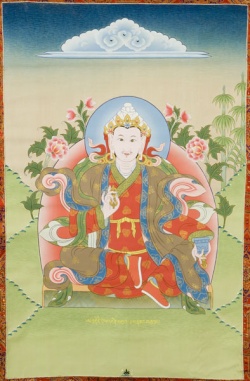Kalki.
In the Indo-Tibetan Vajrayana Buddhist tradition, there are thirty-two Kings of Shambhala, a mythical kingdom.
The first notable king of Shambhala, King Suchandra (sometimes wrongly Sanskritized as "Chandrabhadra," Tib. Dawa Sangpo), was the one who requested teaching from the Buddha. In response to his request, the Buddha gave the first Kalachakra root tantra. By practicing the Kalachakra the whole of Shambhala became an enlightened society, with Suchandra as the ruler. He was followed by an additional six Dharmarajas (Truth Kings). His eighth successor, Manjushri Yashas (sometimes wrongly Sanskritized as "Manjushrikirti"), was the first to be known as the Kalki King (Tib. Rigden, wylie: rigs ldan), to be followed by 24 more leading up to the present day.
Kalki; Yashas (Tib. Jampal Dakpa; "Manjushri Yashas") - King Yashas is said to have lived in the second century BCE. He put the Kalachakra teachings in a condensed and simplified form called the "Sri Kalachakra" or "Laghutantra". He also converted a group of non-Buddhist Brahman priests of Shambhala to Buddhism and gave them the Kalachakra initiation, thereby uniting all inhabitants into one "vajra caste," or family of tantric practitioners. He said to have predicted the coming of "barbarian Dharma" after 800 years (about 600 CE), which indicates a form of Islam. 1. Yaśas (grags pa(), an emanation of Mañjugoṣa, the king who converted the ṛiṣis to the single vajra-caste. He composed the Laghu-tantra.
- Pundarika (Tib. Pema Karpo) (176-76 BCE) - White Lotus, Cherished by the Lord of Potala. King Pundarika wrote a commentary called "Vimalaprabha" (Skt.) or "Stainless Light." This text, together with the Sri Kalachakra, is the source text of the Kalachakra system as it is now practiced. Other practice texts are commentaries on these two. The Dalai Lamas are said to be incarnations of Pundarika.
32 kings of Sambhala from the Tibetan tradition. Seven Dharma kings are said to have preceeded the Kalkī (rigs ldan) kings, who's number is 25.
- Suchandra (Tib. Dawa Sangpo) c. 900 to 876 BC. Note: the Kalachakra calculations put the life of Shakyamuni Buddha quite a bit earlier than is generally accepted, and the Tibetans produced a number of divergent calculations of the dates given here. Also, many of the names of the kings are often wrongly Sanskritized (back-translated from the Tibetan) in Western publications.
- Devendra (Tib. Lhayi Wang) (876-776 BC) - Fond of Sentient Beings
- Tejasvin (Tib. Ziji Chän) (776-676 BC) Bearer of the Dharma Wheel and the Auspicious Conch
- Somadatta (Tib. Dawä Jin) (676-576) Lord of Speakers
- Deveshvara/Sureshvara (Tib. Lhaji Wangchug) (576-476) Destroyer of the City of Delusion
- Vishvamurti (Tib. Natshog Zug) (476-376) Conqueror of False Leaders, Holding a Lotus
- Sureshana (Tib. Lhayi Wangdän) (376-276) Cutter of Delusion, Uprooter of Karma and Klesha
There are some problems with the listing of the kalkī-kings. The general list given in Tibetan texts, and used in the series of pictures shown here, contains 25 names, but the great Indian Kālacakra teacher Vibhūticandra pointed out to Tibetan colleagues that the names of the 18th and 19th in this list, Hari and Vikrama, belonged together as one name, Harivikrama. He also pointed out to them that some Tibetan lists similarly split up the name of number 24 in the list into two names, Ananta and Vijaya. This persists to this day.
The advice of this great Kālacakra teacher was duly noted by the Tibetans but in practice ignored, and their misreading of the Sanskrit when translating into Tibetan was not corrected. Accepting his advice would reduce the list to 24 kings, although the predecessor to Cakrī is in fact another by the name of Yaśas, and his inclusion would return the list to the correct count of 25. He is actually mentioned in a quotation from the Kālacakra Mūlatantra, but this has generally been ignored by Tibetan writers.
The additional error of splitting the name of Anantavijaya would produce a list of 26, unless of course the second Yaśas is omitted, which was generally the case in Tibetan lists.
- Yashas (Tib. Jampal Dakpa; "Manjushri Yashas") - King Yashas is said to have lived in the second century BCE. He put the Kalachakra teachings in a condensed and simplified form called the "Sri Kalachakra" or "Laghutantra". He also converted a group of non-Buddhist Brahman priests of Shambhala to Buddhism and gave them the Kalachakra initiation, thereby uniting all inhabitants into one "vajra caste," or family of tantric practitioners. He said to have predicted the coming of "barbarian Dharma" after 800 years (about 600 CE), which indicates a form of Islam.
- Pundarika (Tib. Pema Karpo) (176-76 BCE) - White Lotus, Cherished by the Lord of Potala. King Pundarika wrote a commentary called "Vimalaprabha" (Skt.) or "Stainless Light." This text, together with the Sri Kalachakra, is the source text of the Kalachakra system as it is now practiced. Other practice texts are commentaries on these two. The Dalai Lamas are said to be incarnations of Pundarika.
- Bhadra (Tib. Zangpo) (76 BC -227 CE) One who Rules by the Thousand-spoked Wheel
- Vijaya (Tib. Nampar Gyäl) (227-327) - Attractor of Wealth, Victorious in War
- Sumitra (Tib. Shenyen Zangpo) (327-427)- Integrator of Method and Wisdom, Victorious over Samsara
- Raktapani (Tib. Rinchen Chag) (427-527) Holder of the Blissful Vajra and Bell
- Vishnugupta (Tib. Kyabjug Bäpa) (527-627) Smiling Holder of the Trident and Rosary
- Suryakirti (Tib. Nyima Drag) (627-727) Annihilator of Wild Demons
- Subhadra (Tib. Shintu Zangpo) (727-827) Holder of the Sword and Shield
- Samudra Vijaya (Tib. Gyatso Namgyäl) (827-927) Annihilator of all types of Devils
- Aja (Tib. Gyälka) (927-1027) Who binds with Unbreakable Iron Chains
- Surya/Suryapada, (Tib. (Wonang) Nyima) (1027-1127) All-Pervading, Radiant Jewel Light
- Vishvarupa (Tib. Natshog Zug(chän)) (1127-1227) Holder of the Vajra Prod and Noose
- Shashiprabha (Also Sasiprabha or Chandraprabha, Tib. Dawäi Ö) (1227-1327) Lord of Secret Mantras, Holder of the Wheel and Conch
- Ananta, Thayä (Tib. Nyen) (1327-1427) Holder of the Mallet that Crushes False Ideas
- Shripaala or Parthiva (Tib. Sakyong) (1427-1527) Holder of the Cleaver that Cuts the Bonds of Ignorance
- Shripala (Tib. Pälkyong) (1527-1627) - Annihilator of the Host of Demons
- Singha (Tib. Senge) (1627 -1727) Who Stuns the Elephant with his Vajra
- Vikranta (Tib. Nampar Nön) (1727 - 1827) Subduer of the Mass of Foes, the Inner and Outer Classes of Devils
- Mahabala (Tib. Tobpo Che) (1827 - 1927) Tamer of all False Leaders by Means of the Sound of Mantra
- Aniruddha (Tib. Magakpa) (1927-2027) - Who Draws and Binds the Entire Three Worlds. Aniruddha, the present Kalki king, was prophesied to rule in a time when Vajrayana Buddhism and the Kalachakra is nearly extinguished.
- Narasingha (Tib. Miyi Senge) (2027-2127) Ruling by the Wheel, Holding the Conch
- Maheshvara (Tib. Wangchug Che) (2127-2227) Victorious over the Armies of Demons
- Anantavijaya (Tib. Thaye Namgyäl) (2227-2327) Holder of the vajra and Bell
- Raudra Chakrin (Tib. Dakpo Khorlocen) (2327 to ? ) Forceful Wheel Holder. The Kalki king prophesied to appear to humans all over the world in 2424 to defeat the degenerate world rulers, establishing a planet-wide Golden Age. He is the last king prophesied in the Kalachakra.
The seven Dharma Kings
| [[File:Skd02b.jpg|thumb|250px|2. Sureśvara (lha'i dbang po), an emanation of Kṣitigarbha)] | [[File:Skd03b.jpg|thumb|250px|3. Tejī (gzi brjid can), an emanation of Yamāntaka.]] | |||
Kalkī Kings
 2. Puṇḍarīka (padma dkar po(), an emanation of Lokeśvara. He composed the tantra commentary, the Vimalaprabhā. |
||||
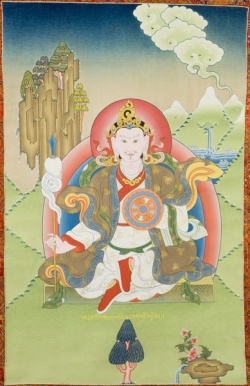 25. Rudracakrī (drag po 'khor lo can), an emanation of Mañjuśrī. He is predicted to defeat the barbarians when they finally try to invade Sambhala. |

